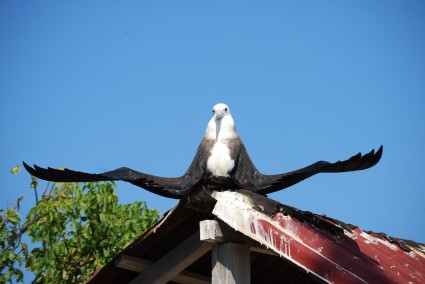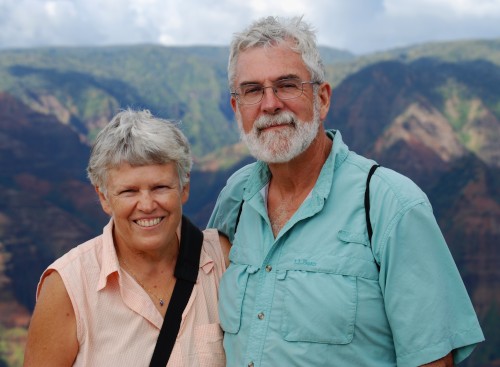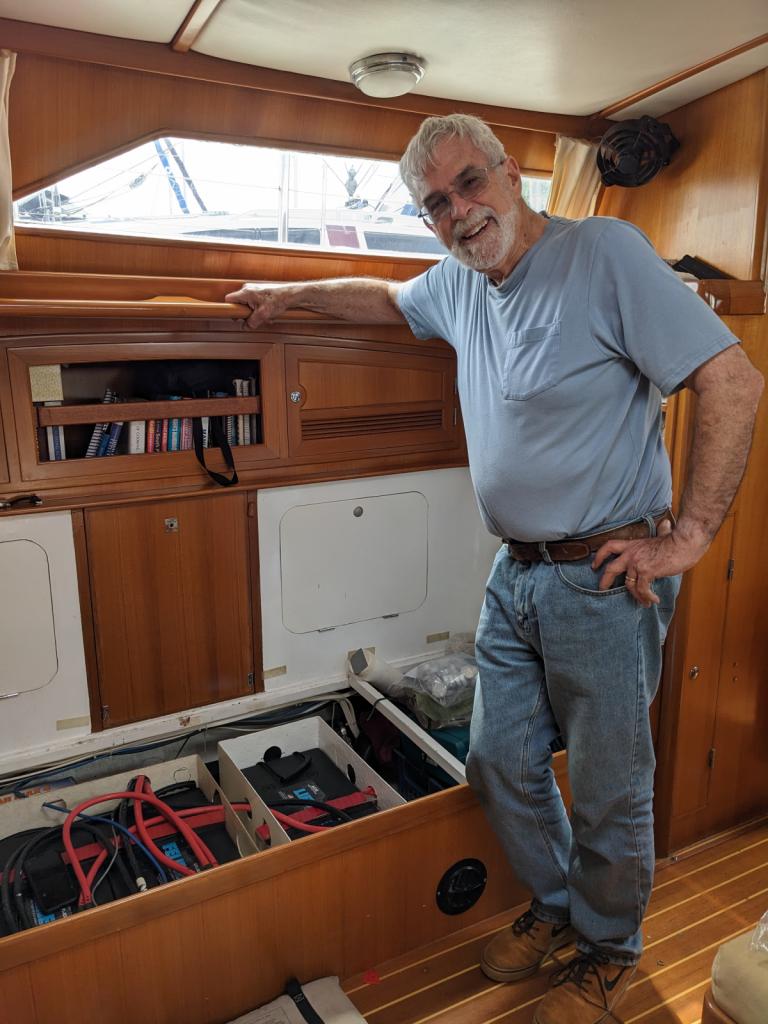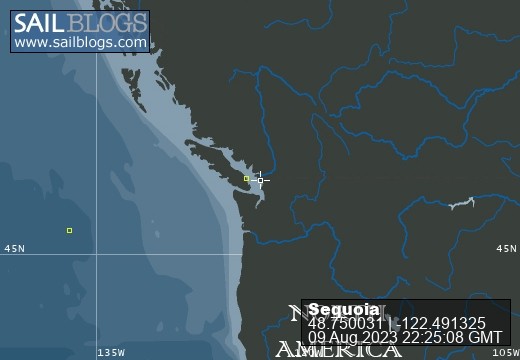
Sequoia Changing Latitudes
30 August 2023 | St. Helens, Oregon
09 August 2023 | Bellingham, Washington
21 July 2023 | Boat: Bellingham; C&B: Scappoose
10 July 2023 | Egmont, Sunshine Coast, B.C., Canada
02 July 2023 | Walsh Cove, Desolation Sound, B.C., Canada
23 June 2023 | Westview/Powell River B.C.
18 June 2023 | Ganges, Saltspring Island, B.C., Canada
22 June 2019 | Scappoose, Oregon
27 May 2019 | Back home in Oregon
09 May 2019 | Villas Alturas Hotel, Costa Rica
02 May 2019 | San Vito, Costa Rica
23 April 2019 | Golfito, Costa Rica
11 April 2019 | Panama City, Panama
04 April 2019 | Shelter Bay Marina, Colon, Panama
22 March 2019 | Jamaica
11 March 2019 | Zar Par Marina, Boca Chica, Dominican Republic
18 February 2019 | Culebra Island, Puerto Rico
31 January 2019 | Simpson Bay Lagoon, Sint Maarten
21 January 2019 | Nelson's Dockyard, English Harbour, Antigua
04 January 2019 | Portsmouth, Dominica
Isla Isabela
14 December 2010 | La Cruz de Huanacaxtle, Nayarit, Mexico
Barbara/sunny, high 70's

I wrote the following on December 10, just after we visited Isla Isabela. Until now we haven't had enough internet connectivity to upload it...
Chacala, Nayarit
December 10, 2010
We arrived last night at this "picturesque fishing village" (-- Lonely Planet) but haven't yet been ashore. Looks like lots of tourists (or at least hopeful local entrepreneurs) have read the description - the palm-fringed beaches are lined with palapas (open air restaurants) waiting for the customers. The anchorage is a bit rolly here: some boats that have perhaps been here longer, have set two anchors, fore and aft. That way you're assured (assuming no bad weather) that your motion will be hobby horsing instead of cradle rocking. Hard to say which is worse. In any case we slept long and soundly last night, even with only one anchor.
We left Mazatlan on Sunday, just at sunset, heading south to arrive at Isla Isabela just after sunrise on Monday morning. The various guides show two anchorages at Isla Isabela: one at the south end where there is a fishing camp on the beach, and the other, on the east side, just south of two large rock formations called "Las Moñas" (Spanish for "the dressmaker forms"). We checked out the south cove, but it looked too rolly, and the chartlets we have show various rocks, just underwater, at varying locations. (As an aside, the official charts showing details like these, are nonexistent in most of Mexico. Instead we must rely on hand-drawn chartlets in various guidebooks, prominently marked "not for navigation." They often - and in this case - don't agree with each other. What would you use them for, if not for navigation?)
But I digress. We motored around to the east side, where 4 different sailboats were anchored. The available anchoring space was surrounded and crowded by many, many crude floats, consisting of bleach bottles, old pieces of Styrofoam and boat fenders. There were a number of pangas (small open fishing boats) tending the floats, pulling up nets apparently attached to the floats, and setting new ones. We found a spot, and put our anchor down in beautiful crystal clear water. We could see the anchor on the bottom. We could see tropical fish among the rocks below. We had aimed the anchor for a patch of sand, but instead it wound up on a massive rock, apparently part of an old lava flow. We would regret that, because with every wave, and every shift of the slightest breeze, the chain would move across the lava rock, transmitting every sound to the bow of the boat, a few feet from our (attempting to sleep) ears. On our first snorkel, Craig and I were able to lift up the anchor enough to move it to the patch of sand, but never mind, the chain was still across the huge rocks. In three days, the anchor never did dig in, because there was never enough wind to pull the chain. So in the end it didn't matter whether the anchor was sitting on the lava flow, on the sand, or not even present at all.
The snorkeling was fabulous! We managed to leave all our tropical fish books at home, so I don't remember all the names, but there were convict fish, Moorish idols, angelfish, and plenty of smaller and larger ones. The guys on the pangas were catching huachinango (red snapper) and they wanted to trade us some, even as we were putting down the anchor. We put them off that first day, but the next day they were back, and we acquired two huachinango. The price? They wanted cookies and Coke. We didn't have any cookies we were willing to part with, but we found some packets of trail mix they liked, and we gave them our last three Cokes. (Obviously Coke is a desirable trade good - we don't drink it ourselves, but we clearly need to lay in a good supply for future trades.) The pangueros told us that the fishing camp has no families - men only. And apparently they sustain themselves on cookies and Coke. They seemed very friendly. One took minutes of video with his pink cell phone, memorializing us, our boat, and all its equipment. That afternoon they stopped by with a huge red fish ("pargo"?) and a hammerhead shark. No thanks!
We got together for dinner that evening with Ann and Mark of Blue Rodeo, which was anchored close by. The little huachinangos from the morning's trade were delicious barbecued. We made plans to rendezvous the next morning to go ashore and explore the island. We were joined by Don and Deb of Buena Vista and we landed our dinghies in the south cove, on the beach in front of the fishing camp. The fishing camp consists of 12-14 galvanized iron palapas (sheds) in varying states of disrepair and rust. Furniture consists of the molded plastic tables and chairs which are available so cheaply everywhere. One sign indicated that the government has a project to update the palapas in the very near future, planning to spend $75,000 pesos. Other signs indicate that the island is a national park, dedicated to conservation consistent with development and eco-tourism. Various paths around the island are shown on one sign.
Already, the birds for which the island is famous were in evidence everywhere. The signs were streaked with white bird guano. On top of the national park sign there was a small roof, and on top of that, a frigate bird seemed to be permanently camped, sitting on his outspread wings, in a gesture that looked for all the world like he was gesturing, "Whatever!" There were lots of frigate birds wheeling in the air, pelicans sitting in the water, but no sign yet of the blue footed boobies for which the island is so famous.
Along the base of the hill behind the camp are 10 or 20 plastic outhouses, every 10 feet or so. Each outhouse is painted with a number and/or a name. The paths around the island begin by walking between two of the outhouses, and finding the concrete steps climbing upward through the forest. The forest seems to consist entirely of one species of tree, uniformly about 12 -15 feet high, with leaves like a ficus benjamina and small fruits or nuts the size and color of small limes. On top of the trees, the frigate birds were flying around, and establishing nests in the canopy. Some birds sat on nests, others were building nests, and still others were still looking for mates. The males have a pouch under their beak, and when they're looking for a mate, they inflate the pouch, it becomes bright red, almost translucent, and they make a sort of woodpecker noise with the inflated pouch. After they've found their mate, the pouch deflates, fades to orange then brown, and finally seems to disappear altogether.
The frigates seemed not to care that there were human hikers close by or underneath. We seemed to be invisible to them. I took plenty of pictures, although none that showed the red-pouched males close up.
The blue-footed boobies seemed to be confined to the coastal areas. We saw our first pair of boobies on a cliff overlooking the south bay, and then another in the underbrush as we approached the Las Moñas beach. The pair in the underbrush seemed to be doing a courtship dance, facing each other, heads bobbing up and down, and occasionally touching beaks. (I noticed in reviewing the photos later that this pair had metal bands on their legs. There appears to be some degree of research going on with the birds, although we did not find any bird researchers. Later, on the beach, we did talk with some fisheries researchers who were spending a week there.)
The blue feet are certainly striking. It's almost as though they have their party shoes on. We noticed that some boobies have pale yellow feet, and we speculate that those may be the adolescents. When we reached the shore, there were thousands of boobies, most with blue feet. A few were doing the courtship dance, others were sitting on nests, but most just standing around. They certainly were aware of us, and kept a careful eye on us if we seemed to get too close (I was very glad to have the telephoto lens on the camera).
The trail to reach the Las Moñas coast was strenuous - plenty of steep ups and downs, with occasional bushwhacking where the trail wasn't very obvious. When we got close to the coast, the grasses were covered with burrs, which soon covered each of us. These were the most aggressive burrs I've ever seen, and must have been the particular subspecies that inspired Velcro. In the center of the island is a perfectly round crater lake, green and dank looking, with various evidence of civilization floating in the middle (Coke bottles) or scattered around the edge (an old wheelbarrow, with only shards of rusted metal and a perfectly intact wheel).
Back on the beach of the south cove (Bahia Camchin according to the government sign and the labeling on some of the pangas, but not identified as such on any chart), we saw a stingray which one of the pangueros had caught, and then turned over to a government researcher. I asked the researcher about the line-dancing behavior of the rays we had seen off Cabo San Lucas (see my previous email), but he didn't really know - maybe trying to shake loose some parasites? I still prefer to think of them as having fun.
While we were anchored by Las Moñas, several boats came and went. Others stopped by and looked at the anchorage, moving on, apparently having decided it wasn't secure enough, or too many rocks, or too crowded, or too many fishing floats. For ourselves, we were really glad to have spent three days there. The snorkeling was spectacular, and the birds unlike anything we've ever seen.
Christmas is fast approaching, and we'll be heading to the Bay Area for Christmas, leaving the boat in or around Puerto Vallarta for a few weeks. So right now there are conflicting pulls on our time. Christmas presents? Christmas cards? Hard to think about in this tropical climate.
All the best to friends and family!
Craig & Barbara Johnston
S/V Sequoia
Chacala, Nayarit
December 10, 2010
We arrived last night at this "picturesque fishing village" (-- Lonely Planet) but haven't yet been ashore. Looks like lots of tourists (or at least hopeful local entrepreneurs) have read the description - the palm-fringed beaches are lined with palapas (open air restaurants) waiting for the customers. The anchorage is a bit rolly here: some boats that have perhaps been here longer, have set two anchors, fore and aft. That way you're assured (assuming no bad weather) that your motion will be hobby horsing instead of cradle rocking. Hard to say which is worse. In any case we slept long and soundly last night, even with only one anchor.
We left Mazatlan on Sunday, just at sunset, heading south to arrive at Isla Isabela just after sunrise on Monday morning. The various guides show two anchorages at Isla Isabela: one at the south end where there is a fishing camp on the beach, and the other, on the east side, just south of two large rock formations called "Las Moñas" (Spanish for "the dressmaker forms"). We checked out the south cove, but it looked too rolly, and the chartlets we have show various rocks, just underwater, at varying locations. (As an aside, the official charts showing details like these, are nonexistent in most of Mexico. Instead we must rely on hand-drawn chartlets in various guidebooks, prominently marked "not for navigation." They often - and in this case - don't agree with each other. What would you use them for, if not for navigation?)
But I digress. We motored around to the east side, where 4 different sailboats were anchored. The available anchoring space was surrounded and crowded by many, many crude floats, consisting of bleach bottles, old pieces of Styrofoam and boat fenders. There were a number of pangas (small open fishing boats) tending the floats, pulling up nets apparently attached to the floats, and setting new ones. We found a spot, and put our anchor down in beautiful crystal clear water. We could see the anchor on the bottom. We could see tropical fish among the rocks below. We had aimed the anchor for a patch of sand, but instead it wound up on a massive rock, apparently part of an old lava flow. We would regret that, because with every wave, and every shift of the slightest breeze, the chain would move across the lava rock, transmitting every sound to the bow of the boat, a few feet from our (attempting to sleep) ears. On our first snorkel, Craig and I were able to lift up the anchor enough to move it to the patch of sand, but never mind, the chain was still across the huge rocks. In three days, the anchor never did dig in, because there was never enough wind to pull the chain. So in the end it didn't matter whether the anchor was sitting on the lava flow, on the sand, or not even present at all.
The snorkeling was fabulous! We managed to leave all our tropical fish books at home, so I don't remember all the names, but there were convict fish, Moorish idols, angelfish, and plenty of smaller and larger ones. The guys on the pangas were catching huachinango (red snapper) and they wanted to trade us some, even as we were putting down the anchor. We put them off that first day, but the next day they were back, and we acquired two huachinango. The price? They wanted cookies and Coke. We didn't have any cookies we were willing to part with, but we found some packets of trail mix they liked, and we gave them our last three Cokes. (Obviously Coke is a desirable trade good - we don't drink it ourselves, but we clearly need to lay in a good supply for future trades.) The pangueros told us that the fishing camp has no families - men only. And apparently they sustain themselves on cookies and Coke. They seemed very friendly. One took minutes of video with his pink cell phone, memorializing us, our boat, and all its equipment. That afternoon they stopped by with a huge red fish ("pargo"?) and a hammerhead shark. No thanks!
We got together for dinner that evening with Ann and Mark of Blue Rodeo, which was anchored close by. The little huachinangos from the morning's trade were delicious barbecued. We made plans to rendezvous the next morning to go ashore and explore the island. We were joined by Don and Deb of Buena Vista and we landed our dinghies in the south cove, on the beach in front of the fishing camp. The fishing camp consists of 12-14 galvanized iron palapas (sheds) in varying states of disrepair and rust. Furniture consists of the molded plastic tables and chairs which are available so cheaply everywhere. One sign indicated that the government has a project to update the palapas in the very near future, planning to spend $75,000 pesos. Other signs indicate that the island is a national park, dedicated to conservation consistent with development and eco-tourism. Various paths around the island are shown on one sign.
Already, the birds for which the island is famous were in evidence everywhere. The signs were streaked with white bird guano. On top of the national park sign there was a small roof, and on top of that, a frigate bird seemed to be permanently camped, sitting on his outspread wings, in a gesture that looked for all the world like he was gesturing, "Whatever!" There were lots of frigate birds wheeling in the air, pelicans sitting in the water, but no sign yet of the blue footed boobies for which the island is so famous.
Along the base of the hill behind the camp are 10 or 20 plastic outhouses, every 10 feet or so. Each outhouse is painted with a number and/or a name. The paths around the island begin by walking between two of the outhouses, and finding the concrete steps climbing upward through the forest. The forest seems to consist entirely of one species of tree, uniformly about 12 -15 feet high, with leaves like a ficus benjamina and small fruits or nuts the size and color of small limes. On top of the trees, the frigate birds were flying around, and establishing nests in the canopy. Some birds sat on nests, others were building nests, and still others were still looking for mates. The males have a pouch under their beak, and when they're looking for a mate, they inflate the pouch, it becomes bright red, almost translucent, and they make a sort of woodpecker noise with the inflated pouch. After they've found their mate, the pouch deflates, fades to orange then brown, and finally seems to disappear altogether.
The frigates seemed not to care that there were human hikers close by or underneath. We seemed to be invisible to them. I took plenty of pictures, although none that showed the red-pouched males close up.
The blue-footed boobies seemed to be confined to the coastal areas. We saw our first pair of boobies on a cliff overlooking the south bay, and then another in the underbrush as we approached the Las Moñas beach. The pair in the underbrush seemed to be doing a courtship dance, facing each other, heads bobbing up and down, and occasionally touching beaks. (I noticed in reviewing the photos later that this pair had metal bands on their legs. There appears to be some degree of research going on with the birds, although we did not find any bird researchers. Later, on the beach, we did talk with some fisheries researchers who were spending a week there.)
The blue feet are certainly striking. It's almost as though they have their party shoes on. We noticed that some boobies have pale yellow feet, and we speculate that those may be the adolescents. When we reached the shore, there were thousands of boobies, most with blue feet. A few were doing the courtship dance, others were sitting on nests, but most just standing around. They certainly were aware of us, and kept a careful eye on us if we seemed to get too close (I was very glad to have the telephoto lens on the camera).
The trail to reach the Las Moñas coast was strenuous - plenty of steep ups and downs, with occasional bushwhacking where the trail wasn't very obvious. When we got close to the coast, the grasses were covered with burrs, which soon covered each of us. These were the most aggressive burrs I've ever seen, and must have been the particular subspecies that inspired Velcro. In the center of the island is a perfectly round crater lake, green and dank looking, with various evidence of civilization floating in the middle (Coke bottles) or scattered around the edge (an old wheelbarrow, with only shards of rusted metal and a perfectly intact wheel).
Back on the beach of the south cove (Bahia Camchin according to the government sign and the labeling on some of the pangas, but not identified as such on any chart), we saw a stingray which one of the pangueros had caught, and then turned over to a government researcher. I asked the researcher about the line-dancing behavior of the rays we had seen off Cabo San Lucas (see my previous email), but he didn't really know - maybe trying to shake loose some parasites? I still prefer to think of them as having fun.
While we were anchored by Las Moñas, several boats came and went. Others stopped by and looked at the anchorage, moving on, apparently having decided it wasn't secure enough, or too many rocks, or too crowded, or too many fishing floats. For ourselves, we were really glad to have spent three days there. The snorkeling was spectacular, and the birds unlike anything we've ever seen.
Christmas is fast approaching, and we'll be heading to the Bay Area for Christmas, leaving the boat in or around Puerto Vallarta for a few weeks. So right now there are conflicting pulls on our time. Christmas presents? Christmas cards? Hard to think about in this tropical climate.
All the best to friends and family!
Craig & Barbara Johnston
S/V Sequoia
Comments
| Vessel Name: | Sequoia |
| Vessel Make/Model: | Outbound 44 |
| Hailing Port: | Portland, Or |
| Crew: | Craig & Barbara Johnston |
| About: | |
| Extra: |
Sequoia's Photos - Main
Who we are...

Who: Craig & Barbara Johnston
Port: Portland, Or



